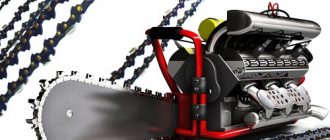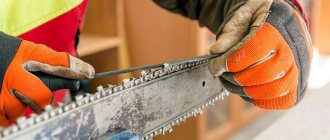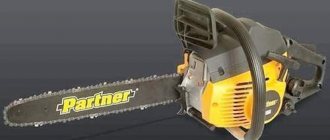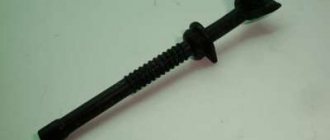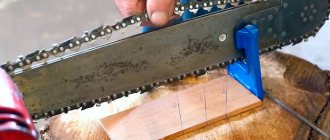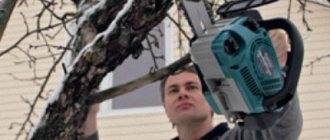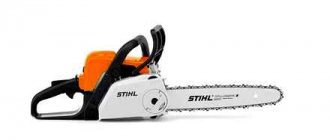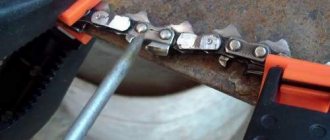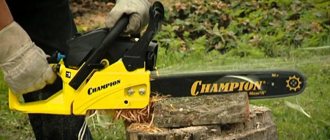How to determine the degree of tension
A quick check of chain tension is very simple: just grab a tooth and pull it up. If the chain is tensioned correctly, the tail will be immersed in the groove of the bar at 1/3 of its height. Exceeding this indicator indicates excessive tension, and a decrease in this indicator indicates weak tension.
Normally, the saw should move freely along the bar, without much effort. If the movement of an element is difficult, this is a sign of excessive tension.
With a strong tension on the cutting element of the chainsaw, the tire begins to heat up and wear down, the load on the engine increases, and it quickly wears out. It is prohibited to turn on the unit with a loose chain, since during sawing it can be pinched and broken, which poses a danger to the user of the unit. The chain can fly off the tire and injure limbs, and it often injures itself and damages the tire. Also, working with a weakened chain element leads to one-sided wear of the bar, after which the device stops making even cuts and the saw moves to the side.
When and how should the chain be changed?
The main sign of critical wear is considered to be excessive stretching of the chain mowing line along the links. Both the main row and the sprocket with the tire are subject to deformation, so the update should be considered comprehensively. If you only plan to replace the chain, then you should resort to a trick, since it is not so easy to install new equipment of the same size on an old tire. For regular work, it is advisable to purchase a headset in three size formats. The main parameter will be the pitch and length. The medium size should be a format that directly matches the characteristics of the tire and sprocket. The alternate use of chains of different formats will correct the interaction between the working bodies and the cutting teeth. This is a kind of running-in of the chain teeth by tension. Chainsaw , in turn, should be used in different modes in terms of engine speed, if such an option is provided in principle.
Other signs that should be a reason to update the chain include mechanical damage to the teeth. Even if there is a theoretical possibility of restoring the equipment, experts recommend discarding the elements requiring repair and switching to a new headset. What parameters to select it for will be discussed further.
READ How to Mount a Circular Saw on a Table
But this approach justifies itself if the chainsaw is rarely used. Professionals need high-quality consumables that will serve them for a long time.
STIHL
Interestingly, even with intensive use of the chain of this brand, the carved element will not stretch. This effect was achieved due to the fact that saw chains are riveted on heated metal. The patented oil groove system ensures that the lubricant is evenly distributed over the entire surface, allowing the chain to last longer.
Here are the most popular STIHL chains in Russia:
These three models meet the needs of professionals and those who use a chainsaw occasionally.
Basic chainsaw chain problems
Chainsaw users often encounter problems with saw chain tension. It either weakens spontaneously or stretches and falls off. As a rule, these troubles are caused by unit breakdowns. Therefore, before proceeding with the procedure for tensioning the chain links, you should check and eliminate possible causes that could lead to adjustment problems.
The reasons that the chain on a chainsaw stretches may be heavy loads or insufficient supply of lubricant to the bar. Because of this, the saw overheats, the metal expands, the size of the saw element increases, and it flies off the tire. The flow of oil may be disrupted if the pump breaks down, the channels become clogged, or the oil hose breaks.
If you have replaced the chain on your chainsaw with a new one, then be prepared for the fact that it will stretch a little during the break-in period. It is only necessary to check the tension in time so that the element does not fly off the tire.
A chain made from low-quality steel is also quickly subject to stretching.
When the driven or driving sprocket wears out, the effectiveness of adhesion to the chain links decreases, causing the saw element to fly off. In this case, you will have to unscrew the chain drive and change the sprocket. Also, the saw blade of the unit may fly off due to its stretching or deformation of the tire.
If the chain on your chainsaw weakens, then this malfunction may be caused by a failed tension mechanism.
Tire wear - how to fix a tire defect
If the guide has uneven wear on both sides, it is recommended to replace it. However, there is a way to restore the part, which will require a minimum set of necessary tools. Leveling is carried out using a grinder and a sharpening disc (not a cutting disc). First, we check the tire and make sure that it has uneven wear. How to check guide wear has already been mentioned above.
Next, consider the instructions on how to eliminate uneven wear on the guide:
- Install a cleaning disc into the grinder spindle, then secure the grinder in a vice
- Make a flat surface on which the guide will be located. It is recommended to use a piece of chipboard as a surface, which must be secured with a clamp.
- Place the square against the surface and align the cleaning disc with the surface.
- Start aligning the tire. To do this, we place it on the surface, turn on the grinders, and carry out its longitudinal movement
- When aligning the guide, it is important to choose a uniform speed for its movement. It is necessary to stitch until both edges are the same size. The check must be performed using a square
Moreover, alignment must be done for both sides of the tire. After finishing the work, you can install the headset on the instrument and check it. It is important to note that aligning a guide that has uneven wear on one side is only appropriate if the groove is deep enough to accommodate the chain shank. If the groove becomes shallow, the tire must be replaced.
As you can see from the material, there are many reasons why a chainsaw cuts crookedly. However, even a beginner can find this reason and eliminate it if he approaches this issue appropriately. Start checking in order, as indicated in the description, and you will definitely identify causes that can be eliminated in various ways.
The chainsaw bar is the guiding and fixing element of the saw set. The blade itself, the drive sprocket and fasteners are consumables.
Working with a broken tire is very dangerous, since at high speeds it can fall off the body and injure the operator, or due to poor fixation on such a tire, the chain and cause injury.
Most often, wear of this element of the chainsaw occurs naturally, due to long-term use. Since it bears the main load when cutting. But there are situations when the tire breaks due to improper use of the tool. Excessive load beyond the specifications of the tool.
Or lack of proper chainsaw care. In addition, it also happens that a professional or semi-professional tire is installed on a low-power unit, or vice versa, tires intended for household saws are installed on a pro-class and universal tool.
READ DIY Circular Saw Drill
How to determine wear on a chainsaw chain sprocket. What you shouldn't save on.
First of all, tires differ in length. Thus, tires of 11 and 13 inches are suitable for household saws, and 14 - 16 inches for universal and professional saws. The elements also differ in design features. There are blades that are flat and narrow, some that consist of two parts, connected by polyamide, and finally, with a removable head.
Tension algorithm
Before tightening the chain on a chainsaw, you must turn off the engine of the unit, or disconnect it from the mains if it is an electric saw. Do not adjust or replace the saw element while it is hot. If this is done, the metal will shrink after cooling and the tension will be too great, which can lead to increased load on the engine and deformation of the tire.
The chain tensioner is located on the right side of the unit, under the cover, in the place where the brake and clutch are installed and the tire mount is located. On Husqwarna, Stihl, Poulan and Partner chainsaws, the external tensioner looks like an ordinary bolt.
So, to configure the chain element of the device, you need to perform the following steps.
- Slightly loosen the nuts located on the right cover so that the tire does not become distorted.
- After inserting a screwdriver into the tensioner adjusting bolt, begin to rotate it to the right (clockwise). These actions will cause the tire to start moving and the chain will be tensioned. If you rotate the bolt to the left (counterclockwise), the chain links will relax.
- Next, you should tighten the chain until it does not sag or dangle.
- Check the tension of the element: grab the cutting link approximately in the center of the bar and pull it down with a little force. The chain must be tensioned, have elasticity, and the shank of the cutting link must fit into the groove of the bar at approximately 1/3 of its height.
On the Makita electric saw, the tension regulator is designed in such a way that it can be turned without the use of any tools. By rotating it clockwise, you will tighten the chain; if you rotate the adjuster in the opposite direction, the tension of the chain element will weaken.
Why does the spark plug on a chainsaw flood?
Almost always, the prerequisite for flooding a spark plug is a breakdown or clogging of the carburetor. To disassemble, inspect and wash it, the fuel unit will need to be removed.
To do this you need:
- Remove the 3 iron screws and remove the protective plastic cover;
- Carefully remove the upper foam part of the air filter. In this case, it is necessary to inspect the filter element and make sure that there is no need to wash or replace it;
- Remove the fuel hose, being careful not to tear or bend it;
- Remove the drive rod;
- Carefully disconnect the gas supply pipe and the end of the standard cable.
After disassembling the carburetor, you will need to inspect its membrane. It should be intact and elastic. If the surface of the membrane has become hardened, then most likely this is what caused the candle to flood.
Other faulty carburetor elements also need to be replaced, and the remaining old parts must be washed in clean gasoline. After the spare parts have completely dried, it is necessary to assemble the fuel unit and install it on the chainsaw in the reverse order.
Replacing the saw element of a chainsaw
If you need to replace the chain on your chainsaw, follow these steps.
- Remove the cover covering the sprocket. To do this, most often you need to unscrew the fastening nuts.
- After unscrewing the fasteners, remove the cover covering the sprocket coupling.
- Hold the bar with your hand and push it towards the sprocket to loosen the chain.
- Remove the chain element from the drive sprocket.
- Now you need to install the chain on the chainsaw. Take the new saw element and place it on the drive sprocket first.
- Then you need to put the chain on the bar, placing the element in its groove along the entire perimeter. It is important that the links fit correctly onto the driven sprocket located at the top of the tire. When installing, pay attention to the direction of the cutting links. They should be directed in the direction opposite to the unit, on the top of the tire.
- Feed the bar in the opposite direction to the engine to tighten the chain a little.
- After laying the saw element, before putting the cover in place, it is necessary to align the screw through which the tension is adjusted with the adjuster located behind the bar. Only after this can you put on the cover and lightly tighten the nuts. Next, insert a screwdriver into the adjusting screw and apply final tension. How to properly tension the chain was described above.
- Lift the tire slightly and tighten the nuts to secure it. It is important not to overdo it and break the thread.
Chainsaw overheating
Why does the chainsaw get hot? The engine or tire may heat up - in any case, the fault is due to a small amount of lubricant.
- Motor overheating. Incorrect proportion of fuel consistency or pure gasoline has been poured in. Drain the fuel and make a mixture with the correct proportions of oil and gasoline, as indicated by the manufacturer.
- Tire overheating. The oil pump needs to be cleaned or adjusted because... No oil is supplied to the tire.
READ Longitudinal Chains For Chainsaws Difference
Is it possible to shorten the chain yourself?
In the case when the chainsaw chain has stretched so much that it is no longer tensioned, it becomes necessary to reduce its length.
This also has to be done if the existing bar is shorter than the chain, and it is not possible to select a suitable saw element.
You can also expand the saw element by adding new links, which can be purchased separately or removed from a similar one. In stores you can see a chainsaw chain wound on coils, which is sold by the meter. In general, repairing chainsaw chains can be done at home, since finding all the components for it is not difficult.
How to remove a rivet
To change the elements of the chain or shorten it, you will need to disconnect the links as follows. Fix the chain element in a vice and grind off the rivets, namely their protruding parts. To do this, you can use a file or needle file. Make sure that the side parts of the link are not ground down.
It is not recommended to use a grinder, as there is a risk of overheating the links, which will lead to a change in the physical properties of the metal.
Using a beard (what it looks like is shown in the photo below), knock out the rivet.
There is another option for disconnecting the links. This does not require grinding off the rivet heads. Place the link, namely its rivet, over any hole in the metal or over the slightly set jaws of the vice. Next, you should place a tool bit on the head of the rivet and hit it several times with a hammer.
Continue to knock out both rivets one at a time, as they are firmly secured by the opposite part of the link. Gradually the rivets will start to come out of the top of the link and it will come apart.
The advantage of this method is that the rivets can be reused as they do not wear off.
How to connect the links
First, you need to purchase links from a specialized store that match the type of chain you have. You will have to do this if you ground off the rivets when disassembling the chain element. Then you will need to correctly assemble the link, taking into account the arrows indicated on it. Place the assembled element on the anvil and rivet the rivets with gentle blows of a hammer.
Don't be afraid to rivet, as the rivet has a thickening in the central part that serves as a limiter.
Some craftsmen advise connecting the links by welding. This method is suitable if the rivets were ground down with a file. But first you need to experiment on some piece of hardware to choose the appropriate welding mode.
Welding must be carried out with a short and thin electrode. The rivet is welded to the side of the link, and excess metal is removed with a file. The only drawback of this method is overheating of the metal from which the circuit elements are made. As mentioned above, due to overheating, the wear resistance of the links may decrease.
How to make a chainsaw run quietly?
Before you find answers to this question, you need to figure out why gas-powered tools began to work louder.
Signs and causes of this difficulty include:
- sharp shooting sounds or a measured increase in volume when the standard engine picks up speed - a problem with the carburetor;
- repeating knocking sound - contact of adjacent parts;
- a howling sound from the drive side – excess wear on the drive sprocket;
- loud whistling noises – difficulties with the inertia brake.
If there are none of these defects and the operator simply wants to reduce the noise of the running engine, then this can be done by replacing the standard muffler.
For this, prefabricated units from professional chainsaws are ideal. They are designed to muffle the loudest sounds, so they will do an excellent job of normalizing the volume of the internal combustion engines of the least massive chainsaws.
Chainsaw Stihl MS-180 16 Picco
The weight of the chainsaw is 3.9 kg. The engine is gasoline, carburetor, single-cylinder, 2 liters. With. There is also an easy start system, chain lock, and anti-vibration. Chain STIHL Oilomatic PICCO MINI 61 PMN, automatic lubrication system. The length of the tire is 40 cm. A compensator is mounted in the carburetor, which is responsible for fuel consumption, constant power of the chainsaw and the quality of exhaust gases.
READ Why Saw Teeth Are Separated How Teeth Are Separated
| Power hp | 2 |
| STIHL Oilomatic chain | Picco Micro 3 (PM3) |
| Weight kg 1) | 3,9 |
| Specific gravity kg/kW | 2,6 |
| Sound pressure level dB(A) 2) | 97 |
| Sound power level dB(A) 2) | 110 |
| Vibration level left/right m/s? 3) | 6,6/7,8 |
| Chain pitch | 3/8"P |
| Oil tank volume cm | 145 |
Diagnostics and care of the cutting body of a chainsaw
Timely sharpening of teeth protects the mechanism from early wear.
The productivity of a tool depends on a large number of factors. The main factors are the following:
- correct use of the unit;
- adjusting the tension of the cutting body;
- high-quality and timely sharpening of the teeth of the working body.
The degree of tension of the cutting element affects the performance of the unit, and the sharpening of the chain teeth affects the sawing speed.
More often, the degree of dullness of the chain is determined by the degree of reduction in the performance of the chainsaw. If productivity drops, the cutting links require sharpening. In addition, sharpening the cutting edges is required if the saw begins to move to the side. One of the signs of a dull saw is the condition of the chips. When the saw becomes dull, the sawdust is dominated by fine and dusty fractions. With regular maintenance of the unit, the chainsaw will last for a long time. At the same time, the process of sawing wood will not cause any particular difficulties, even when processing hard wood.
If you do not have sufficient experience, it is recommended to seek help from a specialist. Professionals with sufficient experience working with chainsaws are able to determine the technical condition of the equipment during the first inspection. During the inspection, the specialist determines the wear of the equipment, the sharpness of the cutting elements, and the tension of the chain.
Modern models of chainsaws are equipped with automatic adjustment of chain tension. However, such saws require special care to prevent tool failure.
Article rating:
Chainsaw chain rotates at idle Link to main publication
Related publications
- How to make a mower from a chainsaw
Signs of breakdown and self-repair of a chainsaw motor
One of the most common breakdowns of every chainsaw is a malfunction of its motor. Determining that this is the reason is quite simple. Several signs may indicate this problem:
- The chainsaw does not start;
- The motor of the tool is unstable and very noisy;
- The engine manages to start, but it constantly stalls;
- The motor overheats very quickly;
- The chainsaw only works on suction;
- The engine smokes a lot, and the power drops.
If you don’t know how to make a chainsaw work quietly, then first of all you will need to study its design. Only after this can you begin to repair the instrument yourself.
To avoid such mistakes, you should once again study the procedure for starting a chainsaw with a cold engine. The algorithm of actions is as follows:
- Lower the throttle switch to the "Close" position;
- Press the carburetor primer several times;
- Pull the starter handle until resistance appears;
- After the saw starts and immediately stalls, move the damper lever to the “Open” position;
- Start the chainsaw again and let it idle for a while.
If this does not help, then you will need to inspect the spark plug. If you see a large amount of oil on it, then the part needs to be unscrewed and dried. After this, you will need to dry the combustion chamber, screw in the spark plug and try to start the saw again.
The serviceability of the spark plug itself can be checked as follows. First, you need to connect a high-voltage wire to it, place the spare part on the cylinder and pull out the starter cable. In this case, do not grab the candle with your hands under any circumstances. If you notice a blue spark, it means the spark plug is fully operational. Screw the part back into place in the chainsaw and restart the engine. If this does not help, then it’s time to check the ignition system and the wires connected to the spark plug.
If there are large stains of fuel on the spark plug, you will need to check the carburetor of the tool. If a thick layer of black carbon deposits has formed on the part, then the problem may lie in the use of low-quality motor oil - quite often this is the reason why the chainsaw spark plug floods. The product must be replaced, and the candle must be thoroughly cleaned with a needle or awl.
Read also: How to choose the right compressor
When checking the spark plug, be sure to pay attention to the distance between the electrodes - it should be from 0.5 to 0.65 mm. Very often, too much distance between the electrodes is the reason why there is no spark.

